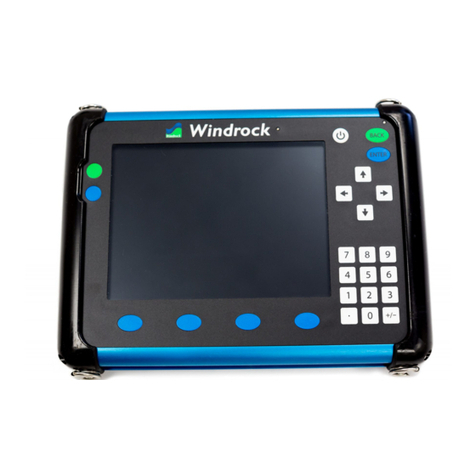
9
Doc No. A3940_UM Rev 1.0
3.5 Spotlight Trunk Cable
The Controller connects to each PUC Module using the Spotlight Trunk Cable. This circular 8-position cable has male and
female ends. This allows for connecting multiple cables together if a longer length of cable is required for installation. Contact
your Windrock representative to purchase additional Spotlight Trunk Cables.
3.6 Spotlight Magnetic Pickup Cable
The Spotlight Magnetic Pickup Cable connects on one end to the magnetic pickup. On the opposite end, the 3-position
connector can either connect directly to the TDC IN of the Controller, or to a Spotlight MPU Extension Cable, or a T-Adapter to
split the signal to multiple Controllers (Section 4.6).
3.7 Spotlight Armored Accelerometer Cable
Each accelerometer Controller connects to each PUC Module using the Spotlight Armored Accelerometer Cable. This circular 2-
position cable has two female ends, one bayonet and one threaded. The bayonet end connects to a PUC Module and the
threaded end screws onto an accelerometer. Contact your Windrock representative to purchase additional cables.
3.8 Worm Drive Clamp Kits
Worm drive clamps are included with new systems to aid installers in routing cabling in order to meet local codes and proper
wiring methods. Refer to Section 5, System Installation for further details.
The A3910 controller is designed to permit use of an external WiFi antenna, connected to the controller ANT2 jack, if
needed to improve connectivity with the A3930 gateway. Such an antenna must be designed for use with 2.4 GHz
frequency (compatible with IEEE 802.11 b/g standards); the cable must terminate in an RP-SMA connector to mate with
the ANT2 jack. In the United States, if a directional WiFi antenna with gain higher than 6 dBi is used with the controller,
FCC regulations require that the transmit power of the controller be reduced by 1 dB for every 3 db that the directional
gain of the antenna exceeds 6 dBi. This rule applies only if the equipment is used for fixed, point-to-point operation;
greater power reduction may be required when directional WiFi antennas are used in other circumstances. The operator
of the equipment, or if the equipment is professionally installed, the installer, is responsible for ensuring that this power
reduction is implemented and that the system is used exclusively for fixed, point-to-point operations. (Reference: Title
47, Code of Federal Regulations, part 15.247.) In general, it is the responsibility of the installer and operator,
respectively, to ensure that legal requirements for installation and operation are followed.Contact Windrock for
information on how to reduce controller transmitter power.
Spotlight Trunk Cable Wire markers were included loose with the system. During installation, it is recommended to attach
wire markers to cables that correspond to the PUC numbers on the controller (ie. PUC1 Controller cables should be
marked with a “1”, etc.). Clip wire markers on at both ends of each trunk cable. If using more than one trunk cable per
PUC, repeat the same wire marker on the extension as well. This way, it will simplify troubleshooting as well as installation
when routing cables around equipment.
Wire markers are installed onto Spotlight Armored Accelerometer Cables at the factory. Markers on these cables will have
a letter and a number at each end. Marker numbers indicate corresponding Controller PUC channel number (ie. “1” for
PUC1, “2” for PUC2, etc.). Marker letter corresponds to one of the four local PUC channels, “A” through “D”. Refer to the
Engine Spotlight information sheet included with your system for further details. If an Accelerometer extension cable was
included with the order, mark the cable you are extending in the same fashion. By marking all cables this way, it will
simplify troubleshooting as well as installation when routing cables around equipment.




























